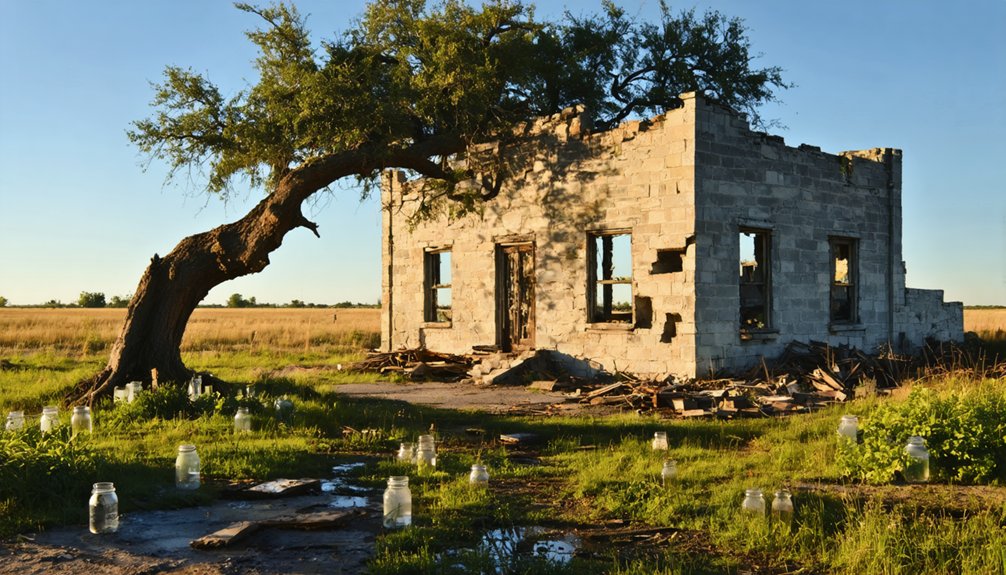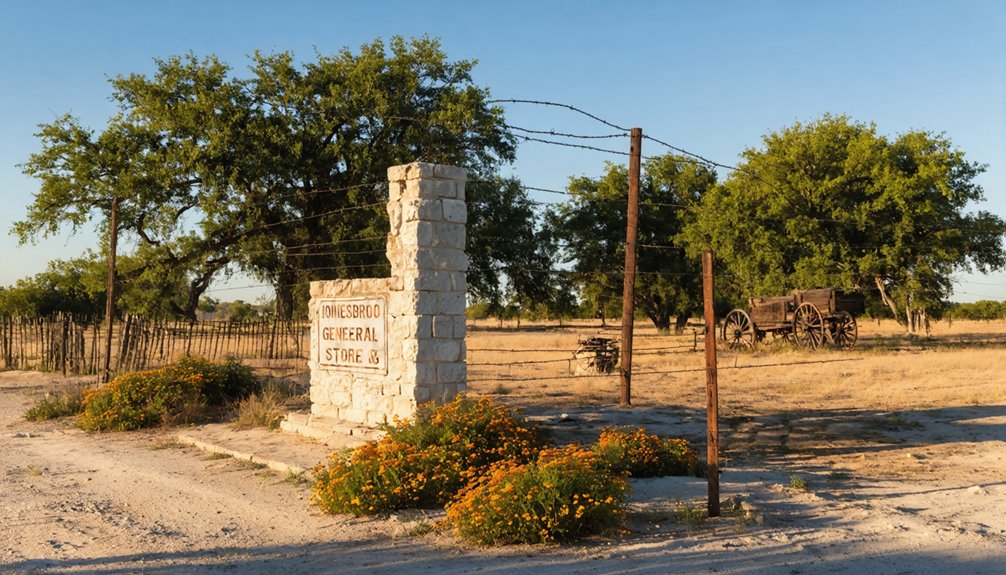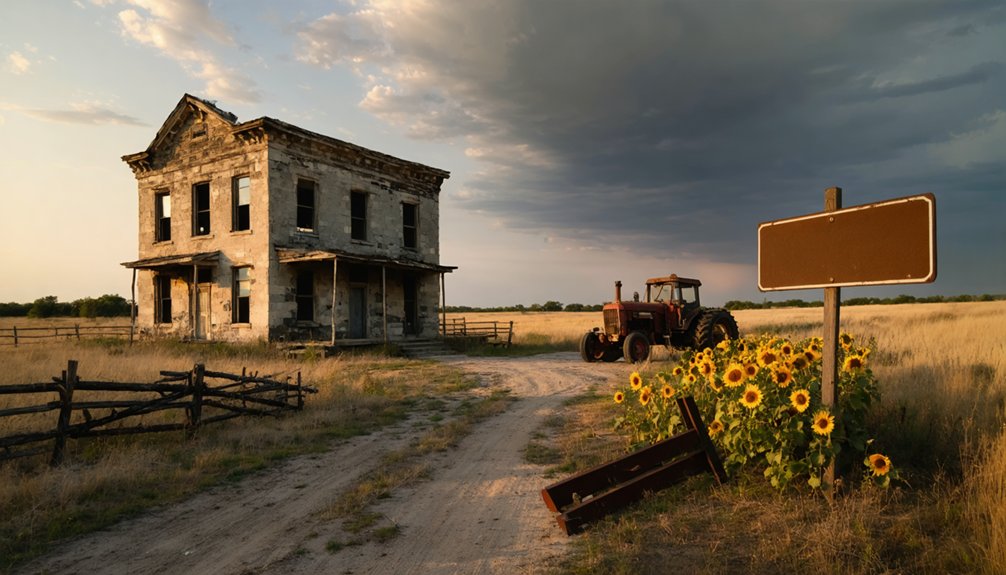You’ll find Jonesboro’s ghost town remains at the intersection of Highway 36 and FM 1602 in Texas, where Henry Jones established an essential ferry crossing in 1814. Originally called Jones Mill, this settlement served as an important port of entry for Anglo-American pioneers heading west. The town thrived until 1843, when a devastating flash flood with rainfall rates of 2-3 inches per hour destroyed the community, claiming 27 lives at nearby Camp Mystic. The site’s haunting story holds deeper secrets about Texas’s frontier heritage.
Key Takeaways
- Originally named Jones Mill, Jonesboro was established by Henry Jones as a port of entry for Anglo-Americans in 1814.
- Located at Highway 36 and FM 1602 intersection, the settlement served as a crucial entry point into Texas territory.
- A catastrophic flood with 2-3 inches of rainfall per hour destroyed the town, causing 27 deaths at nearby Camp Mystic.
- The town became abandoned in 1843, transforming from a bustling frontier settlement into a ghost town.
- Today, the site functions as a roadside park with historical plaques, offering self-guided exploration of Texas frontier history.
The Rise of an Early Texas Settlement
While many Texas settlements emerged after the Civil War, Jonesboro’s story began much earlier as Jones Mill, named after Henry Jones, a prominent ferry owner and hunter who operated along the Red River.
The settlement dynamics of this frontier community were shaped by its strategic location, serving as one of Texas’s first ports of entry for Anglo-Americans as early as 1814. Many settlers moved to the area after troops expelled citizens from north of the Red River. Similar to early Hill County where few settlers existed, the region was largely undeveloped wilderness.
You’ll find evidence of pioneer resilience in the early settlers like Adam Lawrence, Caleb Greenwood, and William Cooper, who established themselves in the area by 1817.
Located at the intersection of modern-day Highway 36 and FM 1602, Jonesboro’s position made it an essential gateway for westward expansion, attracting traders and settlers who relied on its important ferry crossing to enter Texas territory.
Life Along the Red River Frontier
As you explore early life along the Red River frontier, you’ll find that Native American trade networks initially connected Jonesboro’s settlers with crucial resources, including buffalo hides and horses.
You’d have witnessed profound cultural exchanges between settlers and indigenous peoples before military conflicts disrupted these relationships in the 1870s.
Your survival along the river settlement would’ve required adapting to harsh conditions while maneuvering complex social dynamics between military forces, indigenous tribes, and incoming pioneers. The disappearance of buffalo herds devastated traditional trade relationships and led to increasing poverty among Native American communities. The presence of Buffalo Soldiers at nearby frontier forts added another layer to the region’s complex racial and social dynamics.
Early Trade Networks
Located strategically along essential transportation corridors, the Red River frontier developed complex trade networks that connected diverse communities throughout the region during the 18th and 19th centuries.
French traders established important trade routes with the Caddo tribes in the early 1700s, laying the groundwork for future commerce. You’d find the Caddo Confederacies dominating these networks, with their agricultural surplus of corn, beans, and squash supporting extensive trading relationships. They’d established sophisticated kin-based systems that linked various tribes and European traders.
The trade goods flowing through these networks were remarkably diverse. You’d see everything from precious Knife River flint to agricultural products, livestock, and European manufactured items. Following the Old Spanish Road, merchants transported goods between major settlements like Nacogdoches and Santa Fe.
Trading posts like Coffee’s Trading Post became crucial hubs where you could witness the convergence of multiple communities – Comanches, Kiowas, Wichitas, and settlers – all participating in this dynamic frontier economy.
River Settlement Challenges
Life along the Red River frontier presented settlers with intimidating geographic and environmental obstacles that shaped their daily existence.
You’d have faced constant flooding and unpredictable river levels that complicated both farming and river navigation. The winding waterway created natural barriers that made overland travel between settlements particularly challenging.
Your settlement strategies would’ve been tested by dense vegetation that required clearing before you could establish farms or build structures. Spanish authorities actively discouraged settlement through military patrols along the river. The area received 46 inches of rainfall annually, creating additional challenges for early settlers.
The hot, humid climate and irregular rainfall patterns threatened your crops and livestock. Finding clean water proved difficult due to swampy terrain, while Native American presence along the river corridor created a complex dynamic of both trade opportunities and potential conflicts.
Legal uncertainties over land ownership often delayed your ability to make permanent improvements to your homestead.
Frontier Cultural Exchange
During the early 1830s, the Red River frontier emerged as a vibrant crossroads of cultural exchange, where you’d find Anglo settlers, Native American tribes, and merchants forging complex relationships through trade and daily interactions.
The region’s cultural assimilation became evident through:
- Trade networks between Jonesborough merchants and the Choctaw Nation at Doaksville, shaping regional commerce
- Indigenous interactions with Shawnee, Delaware, and Kickapoo tribes who’d settled nearby in the 1820s
- Complex negotiations between settlers and Native Americans over land rights and resources
- Defensive arrangements where you’d see both conflict and cooperation, as settlers organized scouting parties while maintaining essential trade relationships
This frontier dynamic created a unique cultural landscape where you’d witness the convergence of different peoples adapting to survive and thrive along the Red River. Local settlers like Jabez Fitzgerald operated river ferry services with business partners, facilitating crucial transportation and commerce between diverse communities. The thriving community of Jonesborough became a focal point of frontier life when it was chosen as the Miller County seat in 1832.
Notable Historical Figures and Their Connections
While several pioneer families shaped Jonesborough’s early development, Henry Jones stands out as the town’s influential namesake, having hunted along the Red River as early as 1815.
You’ll find that pioneer contributions from Adam Lawrence, Caleb Greenwood, William Hensley, and others established the foundation for the settlement by 1817.
The Stroud family emerged as one of the most influential families, with Ethan and Logan Stroud building their wealth through plantation ownership after 1837. Logan became a prominent slaveholder, constructing the notable Pleasant Retreat Plantation House.
Other key figures like John Robbins and James Walters helped shape the community’s early political landscape.
Despite the courthouse fires of 1873-74 destroying many records, these pioneers’ impact on Jonesborough’s development remains clear through surviving historical accounts.
The Flash Flood That Erased a Town

A catastrophic flash flood in July 2025 devastated Jonesboro and the surrounding Texas Hill Country, marking one of America’s deadliest rainfall disasters in five decades.
The Guadalupe River rose an unprecedented 26 feet in just 45 minutes, releasing destruction that would forever alter the town’s destiny.
The brutal force of nature left an indelible mark on Jonesboro’s history through:
- Rainfall rates of 2-3 inches per hour that overwhelmed the region’s flood control systems
- A record-breaking river crest exceeding 37 feet that destroyed homes and infrastructure within minutes
- Failed town evacuation attempts as floodwaters rose faster than anyone anticipated
- The tragic loss of 27 lives at nearby Camp Mystic, where overnight flooding caught campers off-guard
This devastating event transformed Jonesboro from a living community into a haunting reminder of nature’s raw power.
Legacy in Texas History
Before fading into obscurity in 1843, Jonesboro’s brief but significant existence left an indelible mark on Texas history as a essential entry point into the territory.
In early Texas, Jonesboro stood as a vital gateway, marking the threshold between settled lands and untamed frontier dreams.
You’ll find the ghost town’s historical significance woven into the fabric of Texas’s frontier narrative, where legends like Sam Houston and Davy Crockett first crossed into the promising lands of Texas.
For 28 years, this important hub served as more than just Henry Jones’s ferry crossing – it became a reflection of the pioneering spirit of early settlers.
Though no physical structures remain, Jonesboro’s legacy endures as a symbol of Texas’s dynamic settlement patterns, where communities rose and fell at nature’s whim, and where the promise of freedom drove continuous westward expansion.
Modern-Day Site and Historical Preservation

Today, you’ll find the historic site of Jonesboro near the intersection of Highway 36 and FM 1602 in Coryell County, Central Texas North.
While preservation efforts remain modest, the site functions primarily as a roadside park, offering visitors a chance to connect with Texas history at their own pace.
Current visitor engagement opportunities include:
- Self-guided exploration of the historical site, marked by informative plaques
- Year-round access to the roadside park facilities
- Educational stops for travelers along FM roads
- Opportunities for historical photography and reflection
Located at 31.6148° N latitude and -97.8767° W longitude, the site’s open accessibility makes it an ideal stop for history enthusiasts and casual travelers alike.
Though lacking large-scale restoration projects, the site’s preservation through public parkland guarantees its continued role in sharing Texas heritage.
Frequently Asked Questions
What Daily Activities and Occupations Were Common Among Jonesboro’s Residents?
With 75% of residents involved in agriculture, you’d find farming practices like crop cultivation and hunting dominating daily life, while local trades included merchants, clergy, surveyors, and community administrators.
Were There Any Native American Interactions With the Jonesboro Settlement?
You’ll find Native relations included both conflict and cultural exchange near the settlement, with Caddo, Tonkawa, and Comanche tribes in the area during Jonesborough’s existence along the Red River frontier.
What Specific Buildings and Businesses Existed in Jonesboro Before Its Destruction?
You’d have found the Mercantile Bank Building, local livery stables, wagon yards, union churches, schools, and a courthouse with its Union Street annex among Jonesboro’s historic buildings and local businesses.
Did Any Families Successfully Relocate After the Flood, and Where?
In a heartbreaking exodus, you’ll find that while millions seemed displaced, there’s no documented evidence of specific family relocations or community support networks after the 1843 flood, though some likely moved to nearby settlements.
Were There Attempts to Rebuild Jonesboro After the Devastating Flood?
You’ll find evidence of rebuilding efforts after floods, with locals attempting repairs to homes and infrastructure, though community resilience was challenged by recurring floods and limited resources for sustained reconstruction.
References
- http://texasghosttowns.blogspot.com/2011/09/vanished-ghost-towns.html
- https://www.ghosttowns.com/states/tx/jonesboro.html
- https://en.wikipedia.org/wiki/List_of_ghost_towns_in_Texas
- https://www.texasalmanac.com/places/jonesborough
- https://www.allacrosstexas.com/texas-ghost-town.php?city=Jonesboro
- https://www.texasescapes.com/CentralTexasTownsNorth/JonesboroTexas.htm
- https://www.texasescapes.com/EastTexasTowns/JonesboroTexas.htm
- https://www.tshaonline.org/handbook/entries/jonesboro-tx
- https://www.youtube.com/watch?v=gfeTf9bC2yE
- https://texashistory.unt.edu/ark:/67531/metapth130187/m1/35/



